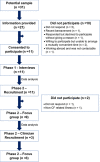Developing an ecological approach to physical activity promotion in adults with Cystic fibrosis
- PMID: 35914006
- PMCID: PMC9342769
- DOI: 10.1371/journal.pone.0272355
Developing an ecological approach to physical activity promotion in adults with Cystic fibrosis
Abstract
Background: There are few examples of interventions designed to promote physical activity (PA) in adults with Cystic fibrosis (CF). Increasing levels of habitual PA may be more feasible and result in greater compliance than conventional exercise training inventions which give little or no attention to long-term PA behaviour. Despite this there is limited research exploring perceptions of PA among adults with CF. The study aimed to understand the ecological correlates of PA in adults with CF and to involve individuals with CF, their families (where applicable) and clinicians in a formative process to inform the development of an ecological approach to PA promotion in this population.
Methods: An iterative approach was utilised, whereby findings from earlier phases of the research informed subsequent phases. Semi-structured interviews were conducted to explore patients' perceptions of PA, devised using the PRECEDE component of the PRECEDE-PROCEED model. Followed by, focus groups to discuss the perceived barriers, facilitators and opportunities for PA participation and how this information could inform the development and delivery of a PA intervention. Separate focus groups were conducted with individuals with CF (n = 11) and their families and CF MDT members. Thematic analysis was used to construct themes.
Results: Physical and mental wellbeing manifested as both barriers and facilitators of PA. CF is characterised by a progressive decline in physical function, which presents as a number of challenging symptoms and set-backs for an individual with CF. PA represents an opportunity for participants to slow the rate of this decline and manage the symptoms associated with the condition. Enjoyment was an important facilitator of PA. Exercise professionals and family reinforce PA behaviour, particularly during adolescence.
Conclusions: PA promotion should form part of routine CF care with additional exercise professional support during adolescence.
Conflict of interest statement
The authors have declared that no competing interests exist
Figures







Similar articles
-
A formative study exploring perceptions of physical activity and physical activity monitoring among children and young people with cystic fibrosis and health care professionals.BMC Pediatr. 2018 Oct 23;18(1):335. doi: 10.1186/s12887-018-1301-x. BMC Pediatr. 2018. PMID: 30352564 Free PMC article.
-
Factors influencing physical activity in adults with cystic fibrosis.BMC Pulm Med. 2021 Apr 2;21(1):113. doi: 10.1186/s12890-021-01482-x. BMC Pulm Med. 2021. PMID: 33810783 Free PMC article.
-
Promotion of physical activity for adolescents with cystic fibrosis: a qualitative study of UK multi disciplinary cystic fibrosis teams.Physiotherapy. 2020 Mar;106:111-118. doi: 10.1016/j.physio.2019.01.012. Epub 2019 Jan 26. Physiotherapy. 2020. PMID: 30992157
-
Physical activity and associations with clinical outcome measures in adults with cystic fibrosis; a systematic review.J Cyst Fibros. 2019 Sep;18(5):590-601. doi: 10.1016/j.jcf.2019.03.003. Epub 2019 Mar 27. J Cyst Fibros. 2019. PMID: 30926321
-
Barriers and facilitators to physical activity among children, adolescents, and young adults with cystic fibrosis: a systematic review and thematic synthesis of qualitative research.BMJ Open. 2020 Feb 20;10(2):e035261. doi: 10.1136/bmjopen-2019-035261. BMJ Open. 2020. PMID: 32086360 Free PMC article.
Cited by
-
Survey of exercise testing and training in cystic fibrosis clinics in the UK: a decade of progress.BMJ Open. 2023 Apr 28;13(4):e072461. doi: 10.1136/bmjopen-2023-072461. BMJ Open. 2023. PMID: 37116999 Free PMC article.
References
-
- Cystic Fibrosis Trust. Standards of Care and Good Practive for the Physiotherapy Management of Cystic Fibrosis (2020). 2020;(November):160–2.
MeSH terms
LinkOut - more resources
Full Text Sources
Medical

